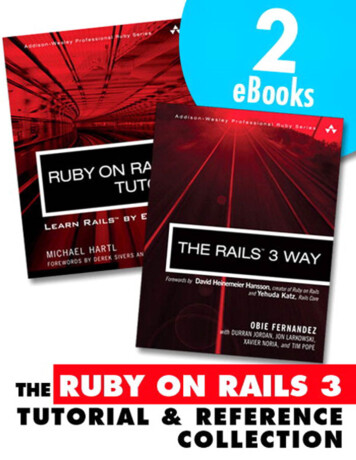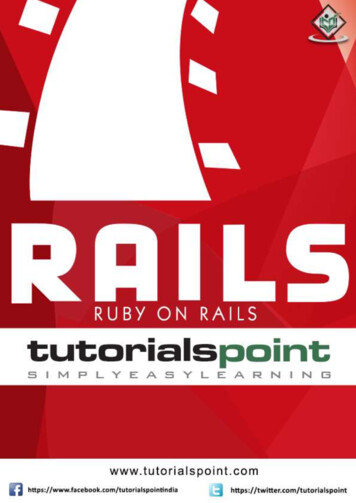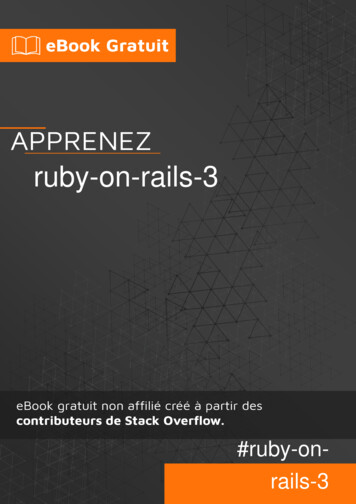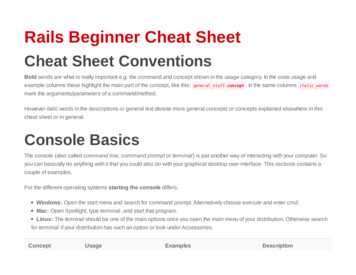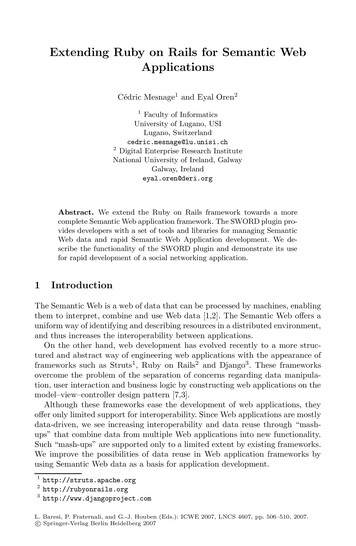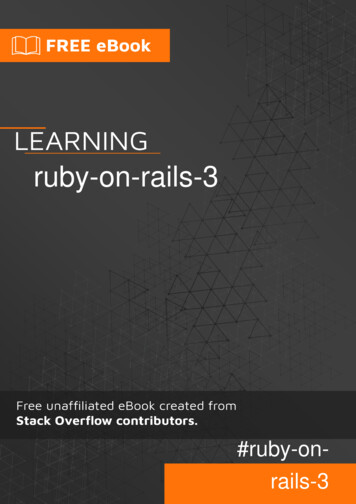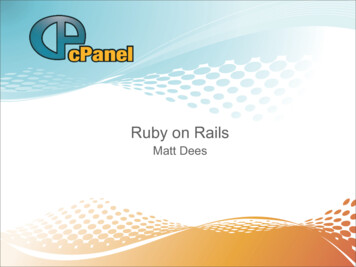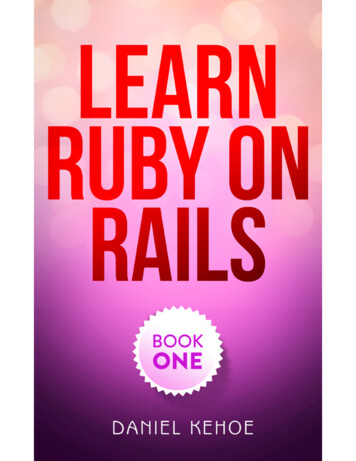
Transcription
2
Learn Ruby on Rails: Book OneVersion 4.0.0, 25 November 2016Daniel Kehoe
ii
Contents1 Free Offer and More1Get Book Two . . . . . . . . . . . . . . . . . . . . . . . . . . . . .1Get the Videos . . . . . . . . . . . . . . . . . . . . . . . . . . . . .1The Online and Ebook Versions . . . . . . . . . . . . . . . . . . .22 Introduction3Is It for You? . . . . . . . . . . . . . . . . . . . . . . . . . . . . .4What To Expect . . . . . . . . . . . . . . . . . . . . . . . . . . . .4What’s in Book One . . . . . . . . . . . . . . . . . . . . . . .5What’s in Book Two . . . . . . . . . . . . . . . . . . . . . .6A Warning About Links . . . . . . . . . . . . . . . . . . . . .6What Comes Next . . . . . . . . . . . . . . . . . . . . . . . .6Versions . . . . . . . . . . . . . . . . . . . . . . . . . . . . .7Staying In Touch . . . . . . . . . . . . . . . . . . . . . . . .7A Note to Reviewers and Teachers . . . . . . . . . . . . . . .7Using the Book in the Classroom . . . . . . . . . . . . . . . .8Let’s Get Started . . . . . . . . . . . . . . . . . . . . . . . .8iii
CONTENTSiv3Concepts11How the Web Works . . . . . . . . . . . . . . . . . . . . . . . . .11Programming Languages . . . . . . . . . . . . . . . . . . . . . . .15Ruby and JavaScript . . . . . . . . . . . . . . . . . . . . . . . . . .15JavaScript and JQuery . . . . . . . . . . . . . . . . . . . . . . . . .16JQuery . . . . . . . . . . . . . . . . . . . . . . . . . . . . . .16Full-Stack JavaScript . . . . . . . . . . . . . . . . . . . . . .17Front and Back Ends . . . . . . . . . . . . . . . . . . . . . . . . .18Rails 5 . . . . . . . . . . . . . . . . . . . . . . . . . . . . . . . . .19JavaScript Frameworks . . . . . . . . . . . . . . . . . . . . . . . .20AngularJS and Ember.js . . . . . . . . . . . . . . . . . . . . .20React . . . . . . . . . . . . . . . . . . . . . . . . . . . . . .214 What is Rails?23Rails as a Community . . . . . . . . . . . . . . . . . . . . . . . . .24Six Perspectives on Rails . . . . . . . . . . . . . . . . . . . . . . .24Web Browser Perspective . . . . . . . . . . . . . . . . . . . .25Programmer Perspective . . . . . . . . . . . . . . . . . . . .25Software Architect Perspective . . . . . . . . . . . . . . . . .25Gem Hunter Perspective . . . . . . . . . . . . . . . . . . . .26Time Traveler Perspective . . . . . . . . . . . . . . . . . . .27Tester Perspective . . . . . . . . . . . . . . . . . . . . . . . .27Understanding Stacks . . . . . . . . . . . . . . . . . . . . . . . . .28Full Stack . . . . . . . . . . . . . . . . . . . . . . . . . . . .28
CONTENTSRails Stacks . . . . . . . . . . . . . . . . . . . . . . . . . . .5 Why Rails?v3033Why Ruby? . . . . . . . . . . . . . . . . . . . . . . . . . . . . . .33Why Rails? . . . . . . . . . . . . . . . . . . . . . . . . . . . . . .35Rails Guiding Principles . . . . . . . . . . . . . . . . . . . . . . .36Rails is Opinionated . . . . . . . . . . . . . . . . . . . . . . .36Rails is Omakase . . . . . . . . . . . . . . . . . . . . . . . .37Convention Over Configuration . . . . . . . . . . . . . . . . .37Don’t Repeat Yourself . . . . . . . . . . . . . . . . . . . . .38Where Rails Gets Complicated . . . . . . . . . . . . . . . . . . . .39When Rails has No Opinion . . . . . . . . . . . . . . . . . .39Omakase But Substitutions Are Allowed . . . . . . . . . . . .39Conventions or Magic? . . . . . . . . . . . . . . . . . . . . .40DRY to Obscurity . . . . . . . . . . . . . . . . . . . . . . . .406 Rails Challenges41A List of Challenges . . . . . . . . . . . . . . . . . . . . . . . . .42It is difficult to install Ruby. . . . . . . . . . . . . . . . . . .42Rails is a nightmare on Windows. . . . . . . . . . . . . . . .42Why do I have to learn Git? It is difficult. . . . . . . . . . . .43Why worry about versions? . . . . . . . . . . . . . . . . . . .43Do I really need to learn about testing? . . . . . . . . . . . . .43Rails error reporting is cryptic. . . . . . . . . . . . . . . . . .44There is too much magic. . . . . . . . . . . . . . . . . . . . .44
CONTENTSviIt is difficult to grasp MVC and REST. . . . . . . . . . . . . .44Rails contains lots of things I don’t understand. . . . . . . . .45There is too much to learn. . . . . . . . . . . . . . . . . . . .45It is difficult to find up-to-date advice. . . . . . . . . . . . . .46It is difficult to know what gems to use. . . . . . . . . . . . .46Rails changes too often. . . . . . . . . . . . . . . . . . . . . .47It is difficult to transition from tutorials to building real applications. . . . . . . . . . . . . . . . . . . . . . . . . .47I’m not sure where the code goes. . . . . . . . . . . . . . . .47People like me don’t go into programming. . . . . . . . . . .487 Get Help When You Need It49Getting Help With Rails . . . . . . . . . . . . . . . . . . . . . . . .49References . . . . . . . . . . . . . . . . . . . . . . . . . . . . . . .50RailsGuides . . . . . . . . . . . . . . . . . . . . . . . . . . .50Cheatsheets . . . . . . . . . . . . . . . . . . . . . . . . . . .51API Documentation . . . . . . . . . . . . . . . . . . . . . . .51Meetups, Hack Nights, and Workshops . . . . . . . . . . . . . . . .51Pair Programming . . . . . . . . . . . . . . . . . . . . . . . . . . .52Pairing With a Mentor . . . . . . . . . . . . . . . . . . . . . . . . .53Code Review . . . . . . . . . . . . . . . . . . . . . . . . . . . . .54Staying Up-to-Date . . . . . . . . . . . . . . . . . . . . . . . . . .548 Plan Your ProductProduct Owner . . . . . . . . . . . . . . . . . . . . . . . . . . . .5757
CONTENTSviiUser Stories . . . . . . . . . . . . . . . . . . . . . . . . . . . . . .58Wireframes and Mockups . . . . . . . . . . . . . . . . . . . . . . .59Graphic Design . . . . . . . . . . . . . . . . . . . . . . . . . . . .60Software Development Process . . . . . . . . . . . . . . . . . . . .61Behavior-Driven Development . . . . . . . . . . . . . . . . . . . .639 Manage Your Project67To-Do List . . . . . . . . . . . . . . . . . . . . . . . . . . . . . . .67Kanban . . . . . . . . . . . . . . . . . . . . . . . . . . . . . . . .68Agile Methodologies . . . . . . . . . . . . . . . . . . . . . . . . .6810 Mac, Linux, or Windows69Your Computer . . . . . . . . . . . . . . . . . . . . . . . . . . . .69Hosted Computing . . . . . . . . . . . . . . . . . . . . . . . . . .70Installing Ruby . . . . . . . . . . . . . . . . . . . . . . . . . . . .70MacOS . . . . . . . . . . . . . . . . . . . . . . . . . . . . .71Ubuntu Linux . . . . . . . . . . . . . . . . . . . . . . . . . .71Hosted Computing . . . . . . . . . . . . . . . . . . . . . . .71Windows . . . . . . . . . . . . . . . . . . . . . . . . . . . .7211 Terminal Unix73The Terminal . . . . . . . . . . . . . . . . . . . . . . . . . . . . .74Unix Commands Explained . . . . . . . . . . . . . . . . . . . . . .75Getting Fancy With the Prompt . . . . . . . . . . . . . . . . . . . .76Learning Unix Commands . . . . . . . . . . . . . . . . . . . . . .76
viiiCONTENTSExit Gracefully . . . . . . . . . . . . . . . . . . . . . . . . . . . .77Structure of Unix Commands . . . . . . . . . . . . . . . . . . . . .78Prompt . . . . . . . . . . . . . . . . . . . . . . . . . . . . . .78Command . . . . . . . . . . . . . . . . . . . . . . . . . . . .79Option . . . . . . . . . . . . . . . . . . . . . . . . . . . . . .79Argument . . . . . . . . . . . . . . . . . . . . . . . . . . . .81Quick Guide to Unix Commands . . . . . . . . . . . . . . . . . . .81cd . . . . . . . . . . . . . . . . . . . . . . . . . . . . . . . .82pwd . . . . . . . . . . . . . . . . . . . . . . . . . . . . . . .83ls . . . . . . . . . . . . . . . . . . . . . . . . . . . . . . . . .83Hidden Files and Folders . . . . . . . . . . . . . . . . . . . .84Dots . . . . . . . . . . . . . . . . . . . . . . . . . . . . . . .86open . . . . . . . . . . . . . . . . . . . . . . . . . . . . . . .87mkdir . . . . . . . . . . . . . . . . . . . . . . . . . . . . . .87touch . . . . . . . . . . . . . . . . . . . . . . . . . . . . . .88mv . . . . . . . . . . . . . . . . . . . . . . . . . . . . . . . .89cp . . . . . . . . . . . . . . . . . . . . . . . . . . . . . . . .90rm . . . . . . . . . . . . . . . . . . . . . . . . . . . . . . . .91Removing a Folder . . . . . . . . . . . . . . . . . . . . . . .92The Mouse and the Command Line . . . . . . . . . . . . . . .93Arrow Keys . . . . . . . . . . . . . . . . . . . . . . . . . . .94Tab Completion . . . . . . . . . . . . . . . . . . . . . . . . .94Why Abbreviations? . . . . . . . . . . . . . . . . . . . . . . . . .94
CONTENTSix12 Text Editor97You Don’t Need an IDE . . . . . . . . . . . . . . . . . . . . . . . .97Which Text Editor . . . . . . . . . . . . . . . . . . . . . . . . . . .98Install Atom . . . . . . . . . . . . . . . . . . . . . . . . . . .98Other Choices . . . . . . . . . . . . . . . . . . . . . . . . . .99How To Use a Text Editor . . . . . . . . . . . . . . . . . . . .99Editor Shell Command . . . . . . . . . . . . . . . . . . . . . . . .9913 Learn Ruby101Ruby Language Literacy . . . . . . . . . . . . . . . . . . . . . . . 102Resources for Learning Ruby . . . . . . . . . . . . . . . . . . . . . 103Collaborative Learning . . . . . . . . . . . . . . . . . . . . . 103Online Tutorials . . . . . . . . . . . . . . . . . . . . . . . . . 104Books . . . . . . . . . . . . . . . . . . . . . . . . . . . . . . 104Newsletters . . . . . . . . . . . . . . . . . . . . . . . . . . . 105Screencasts . . . . . . . . . . . . . . . . . . . . . . . . . . . 10514 Crossing the Chasm107Facing the Gap . . . . . . . . . . . . . . . . . . . . . . . . . . . . 107Bridging the Gap With a Strategy . . . . . . . . . . . . . . . . . . . 109Bridging the Gap With Social Practice . . . . . . . . . . . . . . . . 111Making an Effort . . . . . . . . . . . . . . . . . . . . . . . . 111Conversation Starters . . . . . . . . . . . . . . . . . . . . . . 112Pay It Forward . . . . . . . . . . . . . . . . . . . . . . . . . 112Finding a Mentor . . . . . . . . . . . . . . . . . . . . . . . . . . . 113
CONTENTSxCreating Mentorship Moments . . . . . . . . . . . . . . . . . . . . 114Online . . . . . . . . . . . . . . . . . . . . . . . . . . . . . . 114GitHub . . . . . . . . . . . . . . . . . . . . . . . . . . . . . 115Meetups . . . . . . . . . . . . . . . . . . . . . . . . . . . . . 115Workshops and Classes . . . . . . . . . . . . . . . . . . . . . 116On the Job . . . . . . . . . . . . . . . . . . . . . . . . . . . . 117What’s Next . . . . . . . . . . . . . . . . . . . . . . . . . . . . . . 118Entrepreneurs . . . . . . . . . . . . . . . . . . . . . . . . . . 119Lifestyle Businesses and Personal Projects . . . . . . . . . . . 120Build Applications . . . . . . . . . . . . . . . . . . . . . . . . . . 12115 Level Up123What to Learn Next . . . . . . . . . . . . . . . . . . . . . . . . . . 123Databases . . . . . . . . . . . . . . . . . . . . . . . . . . . . 125Testing . . . . . . . . . . . . . . . . . . . . . . . . . . . . . . 126Authentication and Sessions . . . . . . . . . . . . . . . . . . 127Authorization . . . . . . . . . . . . . . . . . . . . . . . . . . 128JavaScript . . . . . . . . . . . . . . . . . . . . . . . . . . . . 129Other Topics . . . . . . . . . . . . . . . . . . . . . . . . . . . 129Curriculum Guides . . . . . . . . . . . . . . . . . . . . . . . 130Places to Learn . . . . . . . . . . . . . . . . . . . . . . . . . . . . 130Code Camps . . . . . . . . . . . . . . . . . . . . . . . . . . . 131Other Classrooms . . . . . . . . . . . . . . . . . . . . . . . . 132Online Courses . . . . . . . . . . . . . . . . . . . . . . . . . 133
CONTENTSxiVideos . . . . . . . . . . . . . . . . . . . . . . . . . . . . . . 134Books . . . . . . . . . . . . . . . . . . . . . . . . . . . . . . 136A Final Word . . . . . . . . . . . . . . . . . . . . . . . . . . . . . 13716 Version Notes139Version 4.0.0 . . . . . . . . . . . . . . . . . . . . . . . . . . . . . 139Version 3.0.0 . . . . . . . . . . . . . . . . . . . . . . . . . . . . . 140Version 2.2.2 . . . . . . . . . . . . . . . . . . . . . . . . . . . . . 140Version 2.2.1 . . . . . . . . . . . . . . . . . . . . . . . . . . . . . 140Version 2.2.0 . . . . . . . . . . . . . . . . . . . . . . . . . . . . . 141Version 2.1.6 . . . . . . . . . . . . . . . . . . . . . . . . . . . . . 141Version 2.1.5 . . . . . . . . . . . . . . . . . . . . . . . . . . . . . 141Version 2.1.4 . . . . . . . . . . . . . . . . . . . . . . . . . . . . . 142Version 2.1.3 . . . . . . . . . . . . . . . . . . . . . . . . . . . . . 142Version 2.1.2 . . . . . . . . . . . . . . . . . . . . . . . . . . . . . 142Version 2.1.1 . . . . . . . . . . . . . . . . . . . . . . . . . . . . . 143Version 2.1.0 . . . . . . . . . . . . . . . . . . . . . . . . . . . . . 143Version 2.0.2 . . . . . . . . . . . . . . . . . . . . . . . . . . . . . 144Version 2.0.1 . . . . . . . . . . . . . . . . . . . . . . . . . . . . . 145Version 2.0.0 . . . . . . . . . . . . . . . . . . . . . . . . . . . . . 145Version 1.19 . . . . . . . . . . . . . . . . . . . . . . . . . . . . . . 146Version 1.18 . . . . . . . . . . . . . . . . . . . . . . . . . . . . . . 147Version 1.17 . . . . . . . . . . . . . . . . . . . . . . . . . . . . . . 14717 Credits and Comments149
xiiCONTENTSCredits . . . . . . . . . . . . . . . . . . . . . . . . . . . . . . . . . 149Financial Backers . . . . . . . . . . . . . . . . . . . . . . . . 150Editors and Proofreaders . . . . . . . . . . . . . . . . . . . . 150Photos . . . . . . . . . . . . . . . . . . . . . . . . . . . . . . 151Comments . . . . . . . . . . . . . . . . . . . . . . . . . . . . . . . 151
Chapter 1Free Offer and MoreYou are reading Book One, which introduces basic concepts and gives you thebackground you need to succeed.Book One is 99 cents on Amazon and free on my own site. Ill also tell you howto get Book Two plus videos and advanced tutorials.Get Book TwoIn Book Two, you’ll build a useful web application, for hands-on learning. Youshould get started with Book Two right away, for hands-on learning. ReadBook Two when you are at your computer; read Book One for backgroundwhen you are away from the computer. The two books go together, which iswhy I want you to have both books.Get the VideosYou can watch videos as you read the book. A subscription is only 19 permonth (there’s also a discount when you get the video series plus advanced1
CHAPTER 1. FREE OFFER AND MORE2tutorials). You’ll get Book Two when you get the videos: Get Book Two plus the VideosYou can also get Book Two when you buy the advanced Capstone Rails Tutorials, which you’ll want after you finish this book series: Get Book Two plus the Videos and Advanced TutorialsWith the videos and the advanced tutorials, I promise there is no better way tolearn Rails.The Online and Ebook VersionsI’ve created an online version of this book at learn-rails.com. You’ll also findPDF, Epub (iBooks), and Mobi (Kindle) versions available for download. Lookfor the link “Free Online Edition” when you visit the site. It’s free: learn-rails.comYou’ll need the invitation code for the free online and ebook editions: LR1COMI’ll ask you to provide your email address when you sign up to get free access. Iwork hard to keep the books up to date, incorporating improvements and fixingerrors as readers report issues. I update the books often and I send email tonotify of updates. If you bought the book from Amazon or another retailer,email is the only way to learn about updates.Get the ebook version you prefer, get Book Two when you are ready, and let’sget started.
Chapter 2IntroductionWelcome. This is a first step on your path to learn Ruby on Rails.This book contains the background that’s missing from other tutorials. Hereyou’ll learn key concepts so you’ll have a solid foundation for continued study.Whether you choose to continue with another book in this series, a videocourse, or a code school, everything will make sense when you start here.You can read this book anywhere, at your leisure, on your phone or tablet. Usethis book to gain background understanding when you are not at your computer.With Book Two, the next in the series, you’ll need a computer at hand so youcan build your first web application.In Book Two, you’ll build a working web application so you’ll gain hands-onexperience. Along the way, you’ll practice techniques used by professionalRails developers. And I’ll help you’ll understand why Rails is a popular choicefor web development.You can start with Book Two before finishing this book if you’re eager to getstarted building your first application. In fact, I recommend it, because thehands-on learning in Book Two reinforces the concepts you learn in this book.3
CHAPTER 2. INTRODUCTION4Is It for You?If you’ve built simple websites using HTML, you’ll quickly progress to building websites with Rails. Or, if you have experience in a language such as PHPor Java, you’ll make the jump to the Rails framework. But I promise you don’tneed to be a programmer to succeed with this book or the next. You’ll be surprised how quickly you become familiar with the Unix command line interfaceand the Ruby programming language even if you’ve never tried programmingbefore.My books are ideal if you are: a student a startup founder making a career changeIf you are starting a business, and hiring developers, or working alongside developers as a manager or developer, this book will help you talk with developers. However, the true purpose of my book is to help you become you a Railsdeveloper yourself. I want to help you launch a startup or begin a new career.What To ExpectThere is deep satisfaction in building an application and making it run. Withthis book and the next, I’ll give you everything you need to build a real-worldRails application. More importantly, I’ll explain everything you build, so youunderstand how it works.When you’ve completed this tutorial, you will be ready for more advanced selfstudy, including the Capstone Rails Tutorials, textbook introductions to Rails,or workshops and code camps that provide intensive training in Ruby on Rails.
WHAT TO EXPECT5Other curriculums often skip the basics. With this tutorial you’ll have a solidgrounding in key concepts. You won’t feel overwhelmed or frustrated as youcontinue your studies. I think you’ll also have fun!This book and the next are good preparation for: textbooks such as Michael Hartl’s Ruby on Rails Tutorial introductory workshops from RailsBridge or Rails Girls intensive training with immersive code camps Capstone Rails Tutorials from the RailsApps ProjectWe are blessed with many textbooks, workshops, and classroom programs thatteach Ruby on Rails. I believe this book is unique in covering the basics whileintroducing the tools and techniques of professional Rails development.What’s in Book OneBook One is a self-help book that can change your life, though here you won’tfind any inspirational quotes or magical thinking.I explain the culture and practices of the Rails community. I introduce the basicconcepts you’ll need to understand web application development. You’ll learnhow to be a successful learner and how to get help when you need it. I alsoprovide a plan for study so you can learn more when you need it. There’s somuch to learn, it helps to have a map so you know where to go next.Programming can be frustrating and Rails isn’t easy for beginners. The chapter,“Rails Challenges,” describes many of the problems learners encounter. It’snatural to get discouraged so take a look when you begin to feel overwhelmed.Two chapters, “Crossing the Chasm”, and “Level Up”, will help you after youput the book down. Many learners feel stranded if their only experience isstep-by-step tutorials. These chapters are designed to give you a strategy forbuilding an application on your own.
6CHAPTER 2. INTRODUCTIONWhat’s in Book TwoYou’ll start coding in Book Two. It’s a hands-on tutorial that will lead youthrough the code needed to build a real-world web application. Don’t skiparound in Book Two. The tutorial is designed to unfold in steps, one sectionleading to another, until you reach the “Testing” chapter.You can complete Book Two in one long weekend, though it will take concentration and stamina. If you work through the book over a longer timespan, tryto set aside uninterrupted blocks of two hours or more for reading and coding,as it takes time to focus and concentrate.Feel free to start Book Two before you finish this book. Begin coding withBook Two while you get background knowledge from this book at your leisure.Visit tutorials.railsapps.org to learn how to get Book Two.A Warning About LinksMy books are densely packed with links to background reading. If you clickevery link, you’ll be a well-informed student, but you may never finish thebook! It’s up to you to master your curiosity. Follow the links only when youwant to dive deeper.What Comes NextThe best way to learn is by doing; when it comes to code, that means buildingapplications. Hands-on learning with actual Rails applications is the key toabsorbing and retaining knowledge.After you read this book, you’ll be able to work with the example applicationsfrom the RailsApps Project. The project provides open source example applications for Rails developers, for free. Each application is accompanied by atutorial in the Capstone Rails Tutorials series, so there’s no mystery code. Each
WHAT TO EXPECT7application can be generated in a few minutes with the Rails Composer tool,which professional developers use to create starter applications.The RailsApps Project is solely supported by sales of the books, videos, andadvanced tutorials. If you make a purchase, you’ll keep the project going. Andyou’ll have my sincere appreciation for your support.VersionsBook One is relevant and useful for any version of Rails. Book Two requires aspecific version of Rails (the newest at the time it was revised) and shows howto install the latest version of Rails.Staying In TouchIf you obtained this book from Amazon or another retailer, take a moment toget on the mailing list for the book. I’ll let you know when I release updates tothe book. Get on the mailing list for the bookA Note to Reviewers and TeachersThis book approaches the subject differently than most introductions to Rails.It introduces concepts of product planning, project management, and websiteanalytics to place development within a larger context of product developmentand marketing. In Book Two, rather than show the student how to use scaffolding, I introduce the model-view-controller design pattern by creating thecomponents manually. Lastly, though every other Rails tutorial shows how touse a database, Book Two doesn’t, because I want the book to be a short introduction and I believe the basic principles of a web application stand out more
8CHAPTER 2. INTRODUCTIONclearly without adding a database to the application. Though this tutorial isnot a typical Rails introduction, I hope you’ll agree that it does a good job inpreparing Rails beginners for continued study, whether it is a course or moreadvanced books.Using the Book in the ClassroomIf you’ve organized a workshop, course, or code camp, and would like to assignthe book as recommended reading, contact me at daniel@danielkehoe.com toarrange access to the book for your students. The book is available at no chargeto students enrolled in qualified workshops or classes.Let’s Get StartedIn the next chapter, we’ll start with basic concepts.
WHAT TO EXPECTFigure 2.1: The application you will build in Book Two.9
10CHAPTER 2. INTRODUCTION
Chapter 3ConceptsThis chapter provides the background, or big picture, you will need to understand Rails.These are the key concepts you’ll need to know before you try to use Rails.In the following two chapters, you’ll gain a deeper understanding of Rails,including its history, the guiding principles of Rails, and reasons for its popularity. First, let’s consider how the web works.How the Web WorksWe start with absolute basics, as promised.When you “visit a website on the Internet” you use a web browser such asSafari, Chrome, Firefox, or Internet Explorer.Web browsers are applications (software programs) that work by reading files.Compare a word processing program with a web browser. Both word processing programs and web browsers read files. Microsoft Word reads files that arestored on your computer to display documents. A web browser retrieves filesfrom remote computers called servers to display web pages. Simply put, the11
CHAPTER 3. CONCEPTS12World Wide Web is nothing more than files delivered to web browsers by webservers.Web browsers make requests to web servers. Every web address, or URL, is arequest to a web server. A web server responds by sending one or more files.We call this the request-response cycle.Everything displayed by a web browser comes from four kinds of files: HTML - structure (layout) and content (text) CSS - stylesheets to set visual appearance JavaScript - programming to alter the page Multimedia - images, video, or other media filesAt a minimum, a web page requires an HTML file. HTML files contain thewords you see on a web page, along with markup tags that indicate headlines,paragraphs, and other types of text such as lists. If a web browser receivesonly an HTML file, it will display text, with default styles for headlines andparagraphs supplied by the browser.Because it is the World Wide Web, HTML files also contain hypertext links toother web pages. Sometimes links appear in the form of a button or an image.Sometimes a web page contains a form with a button that sends information tothe web server. Links are web addresses, or URLs, and (you guessed it), theyreturn files.If the page is always the same, every time it is displayed by the web browser,we say it is static. Webmasters don’t need software such as Rails to deliverstatic documents; they just create files for delivery by an ordinary web serverprogram. When you learn HTML and create simple web pages, you learn toupload files to a hosting service that provides web servers that deliver yourHTML files to web browsers. In principle, you can run a web server deliveringweb pages from your computer at home but, in practice, most people want a
HOW THE WEB WORKS13web server that runs 24 hours a day and is located in a data center that has fastand reliable connections to the Internet.Static websites are ideal for particle-physics papers (which was the originaluse of the World Wide Web). But most sites on the web, especially those thatallow a user to sign in, post comments, or order products and services, generateweb pages dynamically. When you see a form with a button, you probably arelooking at a page that makes a request to a web application.Dynamic websites often combine web pages with information from a database.A database stores information such as a user’s name, comments, advertisements, or any other repetitive, structured data. A database query can provide aselection of data that customizes a webpage for a particular user or changes theweb page so it varies with each visit.Dynamic websites use a programming language such as Ruby to assembleHTML, CSS, and JavaScript files on the fly from component files or a database.A software program written in Ruby and organized using the Rails developmentframework is a Rails web application. A web server program that runs Rails applications to generate dynamic web pages is an application server (but usuallywe just call it a web server).Software such as Rails can access a database, combining the results of a databasequery with static content to be delivered to a web browser as HTML, CSS, andJavaScript files. Keep in mind that the web browser only receives ordinaryHTML, CSS, and JavaScript files; the files themselves are assembled dynamically by the Rails application running on the server.Even if you are not going to use a database, there are good reasons to generatea website using a programming language. For example, if you are creatingseveral web pages, it often makes sense to assemble an HTML file from smallercomponents. For example, you might make a small file that will be included onevery page to make a footer (Rails calls these “partials”). Just as importantly,if you are using Rails, you can add features to your website with code that hasbeen developed and tested by other people so you don’t have to build everythingyourself.
14CHAPTER 3. CONCEPTSThe widespread practice of sharing code with other developers for free, andcollaborating with strangers to build applications or tools, is known as opensource software development. Rails is at the heart of a vibrant open sourcedevelopment community, which means you leverage the work of tens of thousands of skilled developers when you build a Rails application. When Rubycode is packaged up for others to share, the package is called a gem. The nameis apt because shared code is valuable, like a gem.Ruby is a programming language. Rails is a development framework. Railsis software code written in the Ruby language. It is a library or collection ofgems that we add to the core Ruby language. More importantly, Rails is a setof structures and conventions for building a web application using the Rubylanguage. By using Rails, you get well-tested code that implements many ofthe most-needed features of a dynamic website. When you need additionalfeatures, you can add additional gems.With Rails, you will be using shared standard practices that make it easier tocollaborate with others and maintain your application. As an example, consider the code that is used to access a database. Using Ruby without the Railsframework, or using another language such as PHP, you could mix the complex programming code that accesses the database with the code that generatesHTML. With the insight of years of developers’ collective experience in maintaining and debugging such code, Rails provides a library of code that segregates database access from the
textbooks such as Michael Hartl's Ruby on Rails Tutorial introductory workshops from RailsBridge or Rails Girls . and classroom programs that teach Ruby on Rails. I believe this book is unique in covering the basics while introducing the tools and techniques of professional Rails development. What's in Book One Book One is a self .
